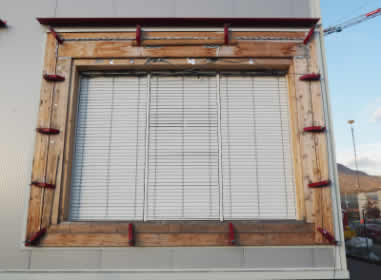
Test of adaptive façade prototypes at the Façade System Interaction Lab of EURAC Research
An ongoing experimental campaign within the Façade System Interaction Lab of Eurac Research is aiming at characterizing and testing two adaptive façade prototypes.
One prototype (left side of the picture) consists of a Double Skin Façade (DSF) characterized by different operating openings placed on both skins, at the top and at the bottom of the façade. This allows different airflow configurations (Thermal Buffer, Supply/Exhaust Air, Outdoor/Indoor Air Curtain), with direct consequences on the façade thermal behavior. Moreover, the cavity of the DSF hosts a venetian blind system, which can be controlled to manage solar radiation.
The second prototype (right side of the picture) is a Single Skin Façade (SSF), characterized by the possibility of operating three different active technologies: external venetian blinds (as in the pictures), venetian blinds integrated in an Insulated Glazing Unit, Liquid Crystal (LC) glazing.
The Design Of Experiment (DOE) was built considering two phases in the experimental campaign: the first designed to characterize the façade systems (considering all the possible configurations of each adaptive component) and the second aimed at implementing control strategies (from simple Rule Base Control strategies to advanced ones).
Results of the two experimental phases will provide essential information at two levels: on the one hand it will help defining improved guidelines to test innovative façade systems; on the other hand, it will allow to gather data while different and advanced control strategies are implemented in real-time.








